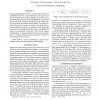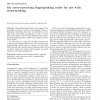IJBIS
2010
14 years 8 days ago
2010
Fingerprinting is a well known approach for identifying multimedia data without having the original data present but what amounts to its essence or "DNA". Current approa...
ICIP
2010
IEEE
14 years 29 days ago
2010
IEEE
Content fingerprinting provides a compact representation of multimedia objects for copy identification. This paper analyzes the impact of the ordinal-ranking based feature encodin...
MMS
2008
14 years 2 months ago
2008
Digital fingerprinting has been suggested for copyright protection. Using a watermarking scheme, a fingerprint identifying the buyer is embedded in every copy sold. If an illegal c...
CORR
2006
Springer
14 years 3 months ago
2006
Springer
Abstract--We address the maximum attainable rate of fingerprinting codes under the marking assumption, studying lower and upper bounds on the value of the rate for various sizes of...
ICMCS
2010
IEEE
14 years 4 months ago
2010
IEEE
The increasingly large amount of digital multimedia content has created a need for technologies to search and identify multimedia files. Multimedia fingerprinting has been widely ...
WISA
2005
Springer
14 years 8 months ago
2005
Springer
In this paper, we present a video fingerprinting system to identify the source of illegal copies. Content is distributed along a specified tree, with the seller as the root of the ...
KES
2005
Springer
14 years 8 months ago
2005
Springer
Digital fingerprinting is a technique to protect digital contents from illegal reproduction and redistribution by marking unique information for individual user. A powerful but sim...
INFOCOM
2006
IEEE
14 years 9 months ago
2006
IEEE
— Network protocol system fingerprinting has been recognized as an important issue and a major threat to network security. Prevalent works rely largely on human experiences and i...
ICCSA
2007
Springer
14 years 9 months ago
2007
Springer
In our recent study, we have presented an approach for tracing illegal users in content distribution networks using watermarking and fingerprinting techniques [1][2]. In this paper...


